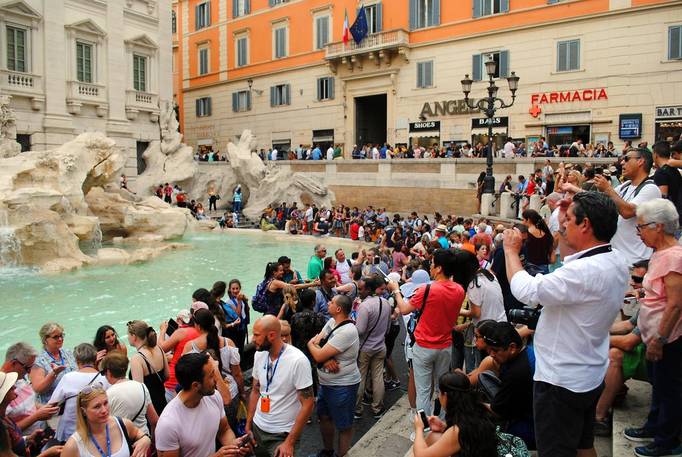


Italy may witness a drop in tourist arrivals this summer, or at least of those tourists who remain a few days and travel by automobile. Reservations for short-term auto rentals have declined.
"For us the situation appears delicate," warns Massimiliano Archiapatti, who heads the mobility sector of Aniasa [2], the national auto rental association. Among the causes, specialists here believe, is the fact that other Mediterranean countries have launched more aggressive tourism promotion campaigns than has Italy. Italy's own political tensions may be scaring some away, as is fear of Brexit among British tourists.
But whether this is altogether a curse or blessing is debatable. The problem is that the number of tourists who remain several days may be waning, but those who rush in and out in a day or a few hours are on the rise.
In 2018, Italy was among the countries most popular for tourists, with 44.4 million international visitors. Of these, the museums, archaeological sites, parks and libraries in what are known as Italy's "cities of art" like Florence attracted 6.6 million foreign visitors, who spent over $176 billion last year. With 27 million visitors, Rome was the single most popular destination, followed by Milan and Venice.
All told, in 2017 the tourist industry attracted 113.4 million visitors, who spent some $44 billion, or 5.3% of its gross domestic product, according to the World Travel and Tourism Council. (The Bank of Italy estimate for the GDP during the same year was slightly lower, at 2.3%, however.)
Who are they? The greatest number of tourists arrive from Germany (almost 60 million last year) followed by French and British, with over 13 million each, and, from the U.S., 12.5 million. For a time after the various terrorist attacks in Europe Chinese tourism slumped, but last year it bounced up again by about 15%. Expect more: Chinese tourism is rising by something like 6% a year across the board in Europe but higher in Italy, by 10%. To date this year ì 3 million Chinese have visited Italy, second only to France as a Chinese preference. Of those arriving, six out of ten are millennials.
This fails to tell the whole story, however, for with them come new problems. Walk down Rome's main street, the Via del Corso, and you will have to battle your way on the narrow sidewalks through hordes of tourists. In Rome previously there would have been a dozen tourists following a flag-bearing leader, but today there are around 50 in the center.
The Vatican is also uniquely stressed from overcrowding. With some 40,000 daily visitors in high season, in many of the halls the air conditioners are on the blink, says the SNGT, the 70-year-old union of Vatican tour guides. "Working conditions are absurd and claustrophobic," said a union spokesman. "And the microclimate created by the mass of sweaty people does no good to the works of art." Those having paid $25 a ticket may have up to two hours waiting in line before they can enter. Security checks account for part of the delay.
The in-and-out tourism of Venice remains one of Italy's most vexing problems. Venice is the third most polluted port city in Europe and Italy's foremost victim of pollution, thanks to the giant ships that bring in the tourist hordes. In 2018 almost two a day of these multi-layered ships traveled the two miles down the Giudecca Canal, from the Isle of San Giorgio to the wharf at San Marco, to introduce 1.56 million tourists into the narrow Venetian streets. According to Tommaso Cacciari, who heads the committee called "No Grande Navi" (No Big Ships), "The politicians either push the issue aside or else they can't resolve it. Or else they just don't want to resolve it."
This week the difficulties presented by chaotic mass tourism are under discussion at a conference in Rome which will see the participation of archaeologist Rita Paris, former director of the Appian Way park area, who accuses the state administration of neglecting this ancient treasure. Italians themselves are tourists, of course, but, from having previously preferred the mountain and seaside resorts, they now tend to flee into the countryside and farm towns.
Source URL: http://iitaly.org/magazine/focus/facts-stories/article/signs-slump-in-tourism-curse-or-blessing
Links
[1] http://iitaly.org/files/trevijpg
[2] https://www.aniasa.it/